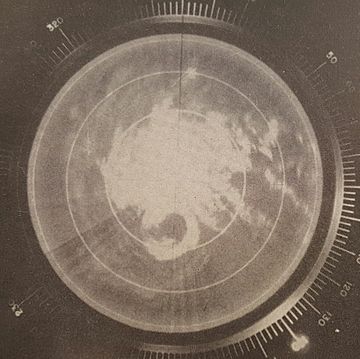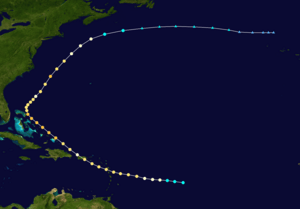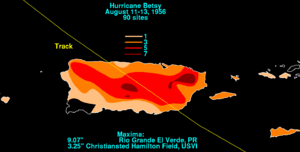Hurricane Betsy (1956) facts for kids
| Category 3 major hurricane (SSHWS/NWS) | |

Hurricane Betsy near landfall in southern Puerto Rico
|
|
| Formed | August 9, 1956 |
|---|---|
| Dissipated | August 18, 1956 |
| Highest winds | 1-minute sustained: 120 mph (195 km/h) |
| Lowest pressure | 954 mbar (hPa); 28.17 inHg |
| Fatalities | 36 direct, 1 indirect |
| Damage | $50 million (1965 USD) |
| Areas affected | Lesser Antilles, U.S. Virgin Islands, Puerto Rico, Hispaniola, Bahamas, East Coast of the United States |
| Part of the 1956 Atlantic hurricane season | |
Hurricane Betsy, also called Hurricane Santa Clara in Puerto Rico, was a powerful storm in 1956. It was the first major hurricane to hit Puerto Rico in 24 years. Betsy started as a small weather disturbance on August 9, 1956, east of the Lesser Antilles.
The storm quickly grew into a strong hurricane with winds of 120 mph (195 km/h). It first hit Guadeloupe, causing a lot of damage to homes and crops. Sadly, 18 people lost their lives there. As Betsy moved through the northeastern Caribbean, it even flipped over a ship, and two sailors died.
On August 12, Betsy reached southeastern Puerto Rico and moved across the island. The areas hit hardest were where the storm first came ashore and the central parts of the island. Over 15,000 homes were destroyed in Puerto Rico. Many farms also suffered, with entire corn crops being lost in some places.
Hurricane Betsy was important for a few reasons. It was the first hurricane ever seen on the radar in San Juan. It also led to the first hurricane warning ever shown on television in Puerto Rico. The hurricane caused about $40 million in damage and led to 16 deaths on the island. Because of the widespread damage, the area was declared a disaster zone. After leaving Puerto Rico, Betsy passed near the Bahamas before heading northeast. It eventually lost its tropical storm power on August 18 and disappeared two days later near Newfoundland.
How Hurricane Betsy Formed and Moved
In early August 1956, the weather conditions in the Atlantic Ocean became perfect for a hurricane to form. A weather system, called a tropical wave, moved off the coast of Africa on August 4. By August 9, a ship reported very rough seas and strong winds. This was the first sign that Tropical Storm Betsy had developed about 835 mi (1345 km) east of Barbados.
The very next day, a special "Hurricane Hunters" plane flew into the storm. They found that Betsy had become a powerful hurricane overnight, with winds of 120 mph (195 km/h). The pilots also noted how small the hurricane was, with an eye (the calm center of the storm) only 10 mi (16 km) wide.
After staying strong for about a day, Betsy started to weaken a little. It passed directly over Marie-Galante and southern Guadeloupe. When it entered the eastern Caribbean, its winds were around 90 mph (150 km/h). From there, it began to move towards the west-northwest.
On August 12, Hurricane Betsy passed about 30 mi (48 km) south of Saint Croix. Then, it hit southeastern Puerto Rico. This was the first time a hurricane had struck Puerto Rico since the 1932 San Ciprian hurricane. As Betsy moved over the island's high mountains, its structure changed, and its eye became hard to see.
However, as it neared the northwest coast, the eye became clear again. Betsy moved off the coast near Camuy with similar strength as when it first hit. The hurricane then grew stronger again as it moved towards the Bahamas. By August 13, its winds reached 110 mph (175 km/h). On that day, the eye passed close to Grand Turk Island and San Salvador Island.
By this time, the storm had grown much larger. The Hurricane Hunters reported that strong winds extended 125 mi (200 km) to its north. The eye became very well-organized again on August 14. The lowest air pressure in the storm was measured at 960 mbar (28.35 inHg). The next day, Betsy turned northeast because of another weather system approaching. Even though it started to weaken, the pressure dropped even lower to 954 mbar (28.17 inHg) on August 17.
The eye of the storm became less clear, and Betsy weakened into a tropical storm on August 18, south of Nova Scotia. It then turned east and changed into a non-tropical storm later that day. Betsy finally disappeared completely on August 20.
Hurricane Betsy's Impact and Damage
When the first warnings for Betsy were given, a hurricane watch was issued for areas from Barbados to Antigua. Soon after, a hurricane watch was also put in place for Puerto Rico and the United States Virgin Islands. This watch was later upgraded to a full hurricane warning. This was a big moment because it was the first hurricane warning ever shown on television in Puerto Rico.
The hurricane hit Guadeloupe with very strong winds, between 100–120 mph (160–195 km/h). This caused a lot of damage to 1,000 homes. Communication systems across the territory were also broken. The strong winds destroyed more than 60% of the banana, breadfruit, coconut, and papaya crops. This was a huge blow to the local economy. In total, the hurricane caused 18 deaths and $10 million in damage across the French West Indies. About $3.5 million of that was just from crop damage. In nearby Dominica, winds reached 69 mph (111 km/h). In Saint Croix, the hurricane brought 3.20 in (81 mm) of rain, and winds reached 86 mph (139 km/h). In the northeastern Caribbean, Betsy caused a ship to flip over, and its two crew members died. Another ship in the area was left drifting for several days south of Saint Croix because its engine was damaged.
When Betsy moved across Puerto Rico, it brought hurricane-force winds to almost the entire island, except for the southwest corner. Sustained winds reached 73 mph (117 km/h) in San Juan. At Ramey Air Force Base in the northwest, wind gusts reached 115 mph (185 km/h). The strong winds knocked down many trees in the island's interior, especially in valleys where the wind was funneled.
In Aibonito, the winds destroyed 1,000 homes and damaged another 500. In nearby Comerío, 1,285 homes were severely damaged or destroyed. In Jayuya, in the central part of the island, the hurricane caused severe crop damage, including a complete loss of the banana crop.
However, the damage was worst in Yabucoa, near where Betsy first came ashore. High winds caused severe damage in a 20 mi (32 km) area. In Yabucoa, over 12,000 people lost their homes, and the damage totaled $8 million. Damage was also very bad where Betsy moved back out to sea in Camuy. The corn crop was completely lost, 95% of avocados, 65% of breadfruit, and 50% of the coffee crop were ruined.
The hurricane also brought heavy rainfall to the central part of the island. The highest amount of rain in 24 hours was 8.72 in (221 mm) in Río Grande. The same station recorded a total of 9.07 in (230 mm) during Betsy's passage, which was the highest total. Across Puerto Rico, Betsy destroyed 15,023 homes and caused $40 million in damage. There were 16 deaths on the island. This number was lower than expected because people listened to the warnings. There were also 24 injuries related to the storm.
Betsy was the first hurricane ever seen on the San Juan radar. On the island, it is remembered as the Santa Clara hurricane. Because of the damage, U.S. President Dwight Eisenhower declared Puerto Rico a disaster area on August 18. This allowed millions of dollars in aid to help with rebuilding. The Puerto Rican governor also set aside $6.7 million to help rebuild.
In San Salvador in the Bahamas, the hurricane produced wind gusts of 132 mph (212 km/h), and sustained winds reached 100 mph (160 km/h). The storm dropped about 5 in (130 mm) of rainfall. Betsy destroyed several houses and damaged the roofs of many churches. Hurricane Betsy caused about $380,000 in damage in the Bahamas.
While delivering supplies to San Salvador Air Force Base, a U.S. Air Force plane crashed. One person was killed in this accident. Officials also issued a hurricane warning for southern Florida, but Betsy stayed far away from the state. However, its eye was seen on radar in Miami from a very long distance of 337 mi (542 km).
In the Grand Banks off the coast of Canada, the hurricane caused a ship to sink. Luckily, the entire crew was rescued.



